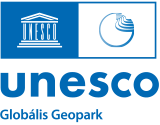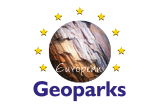The Western Gate of the Geopark opens on 21 January
New visitor centre on karst phenomena: Tapolca Lake Cave Visitor Centre
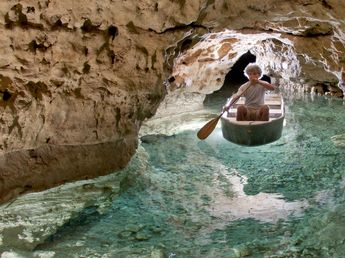 A tortuous cave system is hiding under the streets and houses of Tapolca, a little town not far from Balaton. In the strictly protected cave, which was discovered more than 100 years ago, the visitors can make a unique boat trip on the lit, bluish water of the underground lake.
A tortuous cave system is hiding under the streets and houses of Tapolca, a little town not far from Balaton. In the strictly protected cave, which was discovered more than 100 years ago, the visitors can make a unique boat trip on the lit, bluish water of the underground lake.
From 21 January 2015 visitors are also invited to explore an interactive exhibition in the new Lake Cave Visitor Centre, focusing on the wonderful world of karst. The geological features are interpreted by special attractions, 3D photos and an impressive 3D film. The EU-funded investment is coordinated by the leading organisation of the Geopark, the Balaton Uplands National Park Directorate.
The (Hungarian and English language) leaflet of the new visitor centre can be downloaded from here.
More details: www.lakecave.hu
Norway Grants Application on the way
 The Partner of Bakony–Balaton Geopark, the Bakonyalja Friends Association has applied for grants at the NGO Fund of the EEA/Norway Grants.
The Partner of Bakony–Balaton Geopark, the Bakonyalja Friends Association has applied for grants at the NGO Fund of the EEA/Norway Grants.
The aim of the project is to develop a "geonetwork" of civil organisations that will more effectively inform the local communities about the geological heritage of the Geopark and about the goals of the Geopark. The members of this network would like to actively support the involvement of local communities into activities and the fulfillment of Geopark goals.
The project was successful during the first phase of the application process. The Bakonyalja Friends Association and its partners are working on the detailed project plan to be submitted until 19 January 2015. A questionnaire has been released to assess the needs and knowledge of the people in relation to the Geopark and community involvement. So far more than 100 people have answered the questions and contributed to the project.
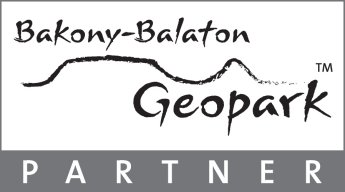 The representatives of eight participating civil organisations and of the Balaton Uplands National Park Directorate – the leading organisation of the Bakony–Balaton Geopark – met to discuss the details of the project at the beginning of January. One more civil organisation and the experts of the Hungarian Novohrad Nógrád Geopark and the Norwegian Magma Geopark also plan to participate in the application process of this initiative. The geonetwork itself will be open for further organisations who would like to become members of the network.
The representatives of eight participating civil organisations and of the Balaton Uplands National Park Directorate – the leading organisation of the Bakony–Balaton Geopark – met to discuss the details of the project at the beginning of January. One more civil organisation and the experts of the Hungarian Novohrad Nógrád Geopark and the Norwegian Magma Geopark also plan to participate in the application process of this initiative. The geonetwork itself will be open for further organisations who would like to become members of the network.
The work goes on and we do hope that the project will be successful!
New Visitor Centre at the Lake Cave of Tapolca
An underground maze, the Lake Cave of Tapolca hides under the streets of the town near Lake Balaton. The cave offers a unique opportunity for boating; besides, from the middle of January in 2015 visitors are also invited to explore an interactive exhibition in the new Lake Cave Visitor Centre, focusing on the wonderful world of karst.
The geological features are interpreted by special attractions, 3D photos and an impressive 3D film. The visitor centre will also function as the Western gate of the Bakony–Balaton Geopark. The EU-funded investment is coordinated by the leading organisation of the Geopark, the Balaton Uplands National Park Directorate.
The Hungarian-English brochure of the new visitor center can be downloaded here.
The website of the Lake Cave of Tapolca can be reached here.
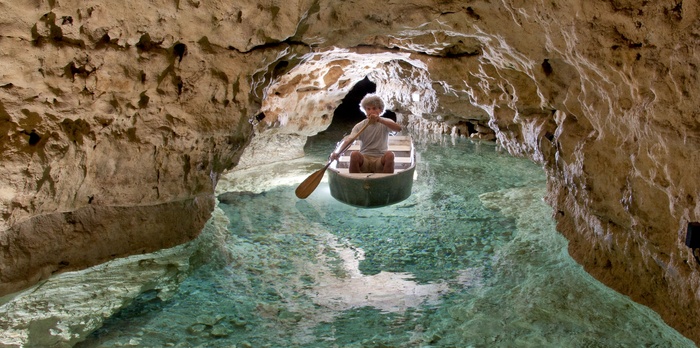
Artworks exhibited in the Lavender House Visitor Centre, Tihany

The Muskauer Faltenbogen/Łuk Mużakowa Geopark invited Polish, German, Hungarian and Czech students from three geoparks for a week in the summer of 2014 to the creative camp „Art Meets Geology”.
The artworks were created with the help of a local potter, glass grinder, painter and wood-carver, using local materials. The students’ creations are exhibited in the workshop room of the Lavender House Visitor Centre until 30. December 2014.
The Muskauer Faltenbogen/Łuk Mużakowa Geopark is located on the border of Germany and Poland. During the trips the students got acquainted with the geological history and the sites related to geology in the Geopark. They also learned a lot about the typical materials that potters, glass grinders, wood carvers and stone carvers use.
Seven students and their teacher from one of the Partners of Bakony–Balaton Geopark, the Fehérlófia Steiner School in Nemesvámos participated in the international camp. A geotourism officer from the Bakony–Balaton Geopark organisation also travelled with them and made a short presentation on the geological heritage and activities of the Bakony–Balaton Geopark. The Polish participant school is planning to visit the Hungarian Geopark next year.

Muskauer Faltenbogen/Łuk Mużakowa Geopark

is recognised as one of the most scenic push moraines in Middle Europe. Its characteristic horseshoe shape was formed some 340,000 years ago as the "Muskauer glacier" advanced from the thick inland ice sheet which covered half of Europe at that time. The load from the ice cover caused subsoil compaction down to a depth of about 300 metres while deforming the horizontal successions of sand, gravel, clay and lignite beds. The unconsolidated rock masses in front of the glacier piled up to form a terminal moraine of some 150 m above today's ground level. The inland ice of the more recent glacial periods flattened the moraine down to today's level, but not entirely, as can be seen from “High Hill” (Hoher Berg) near Döbern (183 m) or the so-called “Dragon Hills” (Drachenberge) near Krauschwitz (163 m).
The Muskau Arch, although initially shaped long time ago, has remained an ever changing landscape until this very day. Today, the Muskau Arch is a picturesque cultural and post-mining landscape full of many and varied lakes, and a natural area of forests exhibiting significant ecological diversity. This beautiful recreational landscape is crossed by a network of theme-based hiking and biking trails.
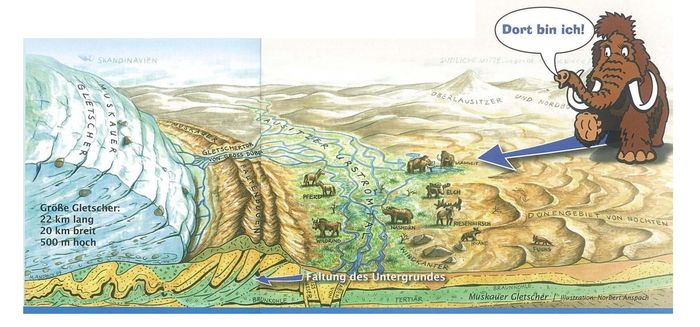
Magyarosaurus dacus in Bakony–Balaton Geopark
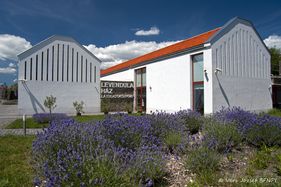 |
| Lavender House Visitor Centre, Tihany |
A full-size replica of Magyarosaurus dacus is travelling from Canada across Europe to reach its "home" in Romania, Haţeg Country Dinosaurs Geopark. The dinosaur lived about 70 million years ago and its remains were found by a Hungarian baron Ferenc Nopcsa, on his family estate at the beginning of the 20th century. Experts say that the relatively small size (6-7 m long) of the reptile is due to the fact that it developed and lived on an island where – unlike huge terrestrial areas – living conditions were limited.
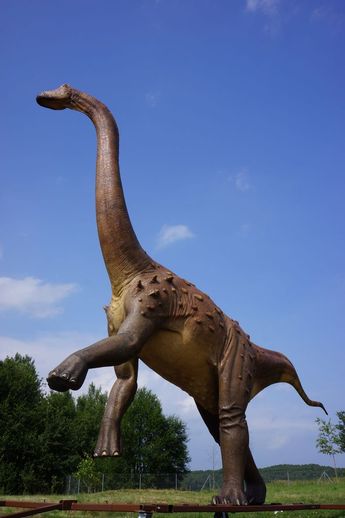
The scientifically accurate replica was created on the basis of the findings discovered in Haţeg. The replica was made by Brian Cooley, a Canadian palaeoartist in cooperation with palaeontologists, geologists and artists. Brian Cooley and his team (including a Canadian filming crew) made a short stop with the replica in Paris and in two of the almost 60 European geoparks: the German Bergstrasse-Odenwald Geopark (World Heritage Site Messel Pit) and the Hungarian Bakony–Balaton Geopark.
During its stay in Hungary the Magyarosaurus dacus was introduced to the public in one of the most beautiful spas at Lake Balaton, the town of Balatonfüred. The following day the replica travelled to the eastern gate of the Bakony–Balaton Geopark, the Lavender House Visitor Centre in Tihany and stayed there for one day. On this unique occasion the Lavender House awaited visitors with dino-workshop for children, dino-cookies and dino-quiz. The Lavender House interprets the exceptionally rich natural heritage of Tihany Peninsula and it is one of the several geotourism possibilities of the geopark and of Balaton Uplands National Park.
Dr. Attila Ősi, an internationally renowned palaeontologist and discoverer of the Hungarian dinosaur findings held a very interesting presentation on the dinosaur fossils of the Carpathian Basin. He talked about the history of the discovery of Magyarosaurus dacus in Transylvania and he also presented the main features of the dinosaur fossils that have been discovered by him and his team since 2000 in Iharkút, Bakony–Balaton Geopark, the only dinosaur location in Hungary.
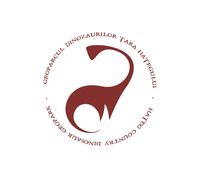 The following slide show and presentation was held by Barnabás Korbély, Head of Bakony–Balaton Geopark Group, who talked about the goals and activities of our geopark and showed the exceptionally diverse geological heritage of the area.
The following slide show and presentation was held by Barnabás Korbély, Head of Bakony–Balaton Geopark Group, who talked about the goals and activities of our geopark and showed the exceptionally diverse geological heritage of the area.
On 17th June the dinosaur replica continued its journey via Budapest where it stayed for a short while in front of the Hungarian Geological and Geophysical Institution.
The team and the replica arrived to Hateg Country Dinosaurs Geopark on 18th June and it is now ready for a trip in Romania and its aspiring geopark areas. Magyarosaurus dacus will return to the Hateg area and will become part of the planned Transylvanian Dinosaur Museum.







